www.natlsunshine.com cheap cialis In machine knitting, frequent color changes are more conveniently made with a color changer. On the Brother KM, the latter is placed on the left side of the machine, so the knit carriage will be knitting by default an even number of rows moving from left to right and back to the left. In turn, the lace carriage will need to move from right to left and back. To retain the same pattern, the card may be flipped over and marked accordingly. Here is an image of the card generated in the previous post, flipped vertically. I prefer colored lines to arrows and other markings: the blue line indicates 2 rows of knitting with KC (a different color could be used to indicate color changes for striping once those are determined), starting row 1 is marked in pencil.
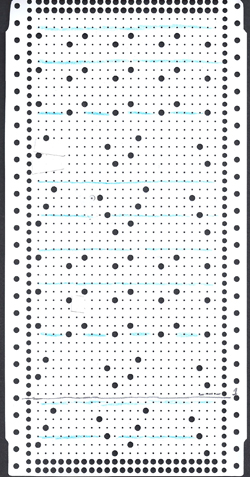 Space-dyed yarns may produce interesting effects, in lace sometimes the pattern is lost, however. In the swatch below I attempted to introduce a random striped sock yarn, thicker than the white previously used. When I loosened the tension for the knit rows, I began to have stitches consistently hung up on gate pegs, adding the second reason to switch my “color 2”. Color changing is every 4 rows, beginning with row 1
Space-dyed yarns may produce interesting effects, in lace sometimes the pattern is lost, however. In the swatch below I attempted to introduce a random striped sock yarn, thicker than the white previously used. When I loosened the tension for the knit rows, I began to have stitches consistently hung up on gate pegs, adding the second reason to switch my “color 2”. Color changing is every 4 rows, beginning with row 1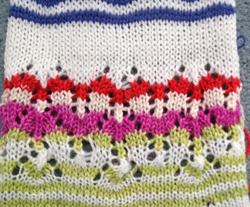 a larger swatch with tension adjustments and switching the 2nd color to equal weight, “friendlier” yarn
a larger swatch with tension adjustments and switching the 2nd color to equal weight, “friendlier” yarn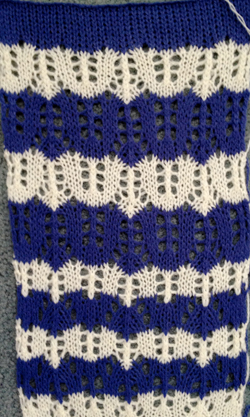
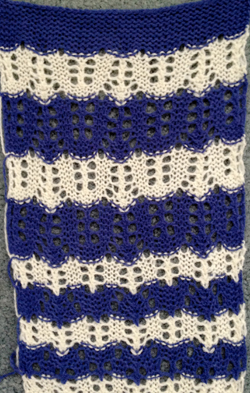 The narrower stripe is spaced 6 rows apart, the wider a full repeat.
The narrower stripe is spaced 6 rows apart, the wider a full repeat.
Like playing with slip stitch variations, there are many more possibilities that could be tried.
Brother card 426, the bottom half repeats once more. The LC makes 26 passes before any knitting occurs, the number of rows knit may be varied from the usual two rows after each design segment to 4, 6, or more or even different combinations.  Knitting the pattern using a fuzzy yarn like rayon chenille results in little difference between knit and purl sides
Knitting the pattern using a fuzzy yarn like rayon chenille results in little difference between knit and purl sides  while the differences are clear in this wool rayon sample.
while the differences are clear in this wool rayon sample. 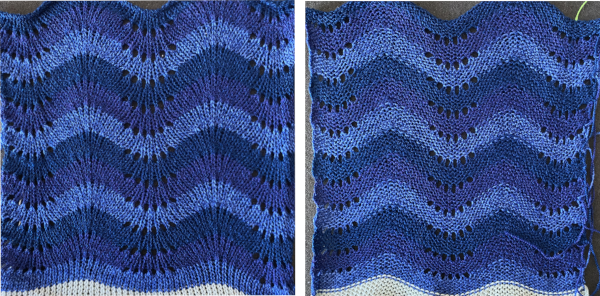 Using space-dyed yarn may at times result in almost clearly defined stripes, but the effect depends on the number of needles in use and the length each color occupies on the final ball or cone of yarn. In a different experiment, the effects testing different patterns are soft and dithered
Using space-dyed yarn may at times result in almost clearly defined stripes, but the effect depends on the number of needles in use and the length each color occupies on the final ball or cone of yarn. In a different experiment, the effects testing different patterns are soft and dithered 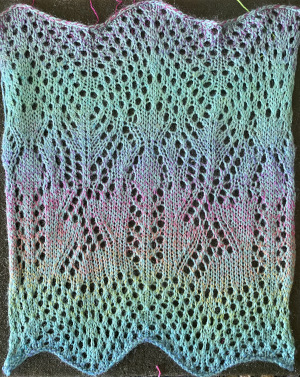 The yarn was used in a shawl:
The yarn was used in a shawl:  Long floats up the side next to the color changer may be wrapped on the end needle periodically and carried up that side to avoid weaving in “all those ends” upon completion of the piece while keeping an eye on whether doing so contributes to the end stitches on both sides resulting in different “lengths” at its edges. Not all lace patterns are equally successful in this technique, and ultimately choices become a matter of personal preference and style. Missoni striped MK laces are a great source of inspiration. For hand knitting, many patterns playing with striping in lace fabrics with both solid and space-dyed yarns may be found at Kieran Foley’s website.
Long floats up the side next to the color changer may be wrapped on the end needle periodically and carried up that side to avoid weaving in “all those ends” upon completion of the piece while keeping an eye on whether doing so contributes to the end stitches on both sides resulting in different “lengths” at its edges. Not all lace patterns are equally successful in this technique, and ultimately choices become a matter of personal preference and style. Missoni striped MK laces are a great source of inspiration. For hand knitting, many patterns playing with striping in lace fabrics with both solid and space-dyed yarns may be found at Kieran Foley’s website.